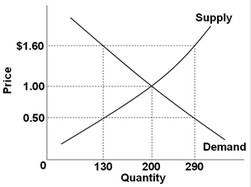A single-price monopoly has marginal revenue and marginal cost equal to $19 at 15 units of output where the price on the demand curve is $38. At this output, average total cost is $15. What is the total profit earned?
A) $225
B) $285
C) $345
D) $570
E) $19
C
You might also like to view...
To answer the next question, use the following graph showing the domestic demand and supply curves for a specific standardized product in a particular nation. If the world price for this product is $0.50, this nation will experience a domestic
If the world price for this product is $0.50, this nation will experience a domestic
A. shortage of 160 units, which it will meet with 160 units of imports. B. surplus of 160 units, which it will export. C. shortage of 160 units, which will increase the domestic price to $1.60. D. surplus of 160 units, which will reduce the world price to $1.00.
More than 80 percent of the home heating oil used in the United States goes to the Northeast. In Vermont, the vast majority of people there use oil to stay warm when it's cold outside
Richard Izor heats his home with oil and inquires, "I'd like to see them come in and put a ceiling on the oil price now before it gets any higher. Why they haven't done this is more than I can understand." Which of the following is NOT likely to occur if such a price ceiling was imposed? A) There would be a surplus of heating oil. B) A heating oil shortage may occur. C) A black market for heating oil may be created. D) There would be an increase in inefficiency in the heating oil market.
Which of the following exemplifies how big-box retailer, such as Walmart or Target, benefits from economies of scale?
a. Each location performs its own negotiations for the purchase of wholesale stock. b. Staff at big-box stores are better positioned to get to know regular customers and connect with them. c. Large-scale ordering allows the purchase of stock at lower costs than smaller firms. d. The web ordering system has become popular with customers who prefer shopping online.
The multiplier applies to:
A. investment but not to net exports or government spending. B. investment, net exports, and government spending. C. increases in spending but not to decreases in spending. D. spending by the private sector but not by the public sector.